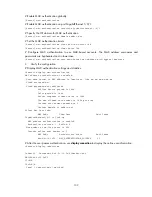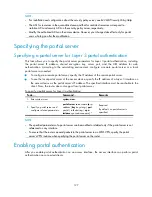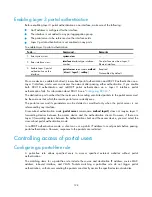
122
4.
The portal server notifies the authentication client of logon success.
5.
The portal server sends a user IP address change acknowledgment message to the access device.
With extended portal functions, the process includes these additional steps:
1.
The security policy server exchanges security check information with the authentication client to
check whether the authentication client meets the security requirements.
2.
Based on the security check result, the security policy server authorizes the user to access certain
resources, and it sends the authorization information to the access device. The access device then
controls access of the user based on the authorization information.
Portal support for EAP authentication process
Figure 48
Portal support for EAP authentication process
Authentication/
Accounting server
Authentication
client
Portal server
Access
device
1) EAP request
2) Authentication request
4) Certificate request
3) RADIUS
authentication
10) Authentication reply
ACK
Authorization
Timer
Security check
5) EAP response
…
6) EAP authentication
…
7) Authentication
success
8) Authentication reply
9) Login success
Security
policy server
All portal authentication modes share the same EAP authentication steps. The following takes the direct
portal authentication as an example to show the EAP authentication process:
1.
The authentication client sends an EAP Request/Identity message to the portal server to initiate an
EAP authentication process.
2.
The portal server sends a portal authentication request to the access device and starts a timer to
wait for the portal authentication reply. The portal authentication request contains several EAP-
Message attributes, which are used to encapsulate the EAP packet sent from the authentication
client and carry the certificate information of the client.
3.
After the access device receives the portal authentication request, it constructs a RADIUS
authentication request and sends it to the RADIUS server. The EAP-Message attributes in the RADIUS
authentication request are those carried in the received portal authentication request.
4.
The access device sends a certificate request to the portal server according to the reply received
from the RADIUS server. The certificate request also contains several EAP-Message attributes, which
are used to transfer the certificate information of the RADIUS server. The EAP-Message attributes in
the certificate request are those carried in the RADIUS authentication reply.
















































